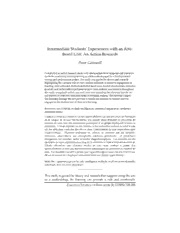Table Of ContentIntermediate(cid:561)Students’(cid:561)Experiences(cid:561)with(cid:561)an(cid:561)Arts(cid:556)
Based(cid:561)Unit:(cid:561)An(cid:561)Action(cid:561)Research(cid:561)
Peter(cid:561)Gamwell(cid:561)
(cid:561)
I(cid:561)conducted(cid:561)an(cid:561)action(cid:561)research(cid:561)study(cid:561)with(cid:561)intermediate(cid:556)level(cid:561)language(cid:561)and(cid:561)literature(cid:561)
students,(cid:561)examining(cid:561)meaning(cid:561)making(cid:561)as(cid:561)adolescents(cid:561)engaged(cid:561)in(cid:561)a(cid:561)developmental(cid:561)
writing(cid:561)and(cid:561)performance(cid:561)project.(cid:561)The(cid:561)study(cid:561)was(cid:561)guided(cid:561)by(cid:561)theory(cid:561)and(cid:561)research(cid:561)
highlighting(cid:561)the(cid:561)valuable(cid:561)role(cid:561)of(cid:561)overt(cid:561)student(cid:561)reflection(cid:561)to(cid:561)improve(cid:561)engagement(cid:561)in(cid:561)
learning.(cid:561)Data(cid:561)collection(cid:561)methods(cid:561)included(cid:561)interviews,(cid:561)teacher(cid:561)observations,(cid:561)reflective(cid:561)
journals,(cid:561)and(cid:561)audio/videotaped(cid:561)performance.(cid:561)Data(cid:561)analysis(cid:561)was(cid:561)iterative(cid:561)throughout(cid:561)
the(cid:561)study,(cid:561)using(cid:561)both(cid:561)within(cid:556)case(cid:561)and(cid:561)cross(cid:556)case(cid:561)sampling,(cid:561)but(cid:561)drawing(cid:561)heavily(cid:561)on(cid:561)
self(cid:556)reports(cid:561)as(cid:561)authentic(cid:561)representations(cid:561)of(cid:561)meaning(cid:556)making.(cid:561)The(cid:561)findings(cid:561)suggest(cid:561)
that(cid:561)learning(cid:561)through(cid:561)the(cid:561)arts(cid:561)provides(cid:561)a(cid:561)vehicle(cid:561)for(cid:561)students(cid:561)to(cid:561)become(cid:561)actively(cid:561)
engaged(cid:561)in(cid:561)the(cid:561)construction(cid:561)of(cid:561)their(cid:561)own(cid:561)learning(cid:561)
Keywords:(cid:561)arts(cid:561)learning,(cid:561)multiple(cid:561)intelligences,(cid:561)emotional(cid:561)engagement,(cid:561)aesthetics,(cid:561)
classroom(cid:561)drama(cid:561)
L’auteur(cid:561)a(cid:561)mené(cid:561)une(cid:561)recherche(cid:556)action(cid:561)auprès(cid:561)d’élèves(cid:561)suivant(cid:561)des(cid:561)cours(cid:561)de(cid:561)littérature(cid:561)
et(cid:561)de(cid:561)langue(cid:561)de(cid:561)niveau(cid:561)intermédiaire,(cid:561)son(cid:561)objectif(cid:561)étant(cid:561)d’étudier(cid:561)le(cid:561)processus(cid:561)de(cid:561)
création(cid:561)de(cid:561)sens(cid:561)chez(cid:561)des(cid:561)adolescents(cid:561)participant(cid:561)à(cid:561)un(cid:561)projet(cid:561)impliquant(cid:561)écriture(cid:561)et(cid:561)
prestation.(cid:561)(cid:561)L’étude(cid:561)reposait(cid:561)sur(cid:561)des(cid:561)théories(cid:561)et(cid:561)des(cid:561)recherches(cid:561)mettant(cid:561)en(cid:561)relief(cid:561)le(cid:561)rôle(cid:561)
clé(cid:561)des(cid:561)réflexions(cid:561)explicites(cid:561)des(cid:561)élèves(cid:561)dans(cid:561)l’amélioration(cid:561)de(cid:561)leur(cid:561)implication(cid:561)dans(cid:561)
l’apprentissage.(cid:561) (cid:561) Plusieurs(cid:561) méthodes(cid:561) de(cid:561) collecte(cid:561) de(cid:561) données(cid:561) ont(cid:561) été(cid:561) utilisées(cid:561):(cid:561)
entrevues,(cid:561) observations(cid:561) des(cid:561) enseignants,(cid:561) journaux(cid:561) personnels(cid:561) (cid:561) et(cid:561) prestations(cid:561)
enregistrées(cid:561)sur(cid:561)cassettes(cid:561)audio(cid:561)et(cid:561)bandes(cid:561)magnétoscopiques.(cid:561)(cid:561)Les(cid:561)données(cid:561)ont(cid:561)été(cid:561)
analysées(cid:561)de(cid:561)façon(cid:561)répétée(cid:561)tout(cid:561)au(cid:561)long(cid:561)de(cid:561)la(cid:561)recherche(cid:561)à(cid:561)l’aide(cid:561)d’échantillons(cid:561)tirés(cid:561)de(cid:561)
l’étude(cid:561) elle(cid:556)même(cid:561) que(cid:561) d’autres(cid:561) études(cid:561) de(cid:561) cas,(cid:561) mais(cid:561) surtout(cid:561) à(cid:561) partir(cid:561) des(cid:561)
autoévaluations(cid:561)en(cid:561)tant(cid:561)que(cid:561)représentations(cid:561)authentiques(cid:561)du(cid:561)processus(cid:561)de(cid:561)création(cid:561)de(cid:561)
sens.(cid:561)(cid:561)Les(cid:561)résultats(cid:561)donnent(cid:561)à(cid:561)penser(cid:561)que(cid:561)l’apprentissage(cid:561)à(cid:561)travers(cid:561)les(cid:561)arts(cid:561)fournit(cid:561)aux(cid:561)
élèves(cid:561)un(cid:561)moyen(cid:561)de(cid:561)s’impliquer(cid:561)activement(cid:561)dans(cid:561)leur(cid:561)propre(cid:561)apprentissage.(cid:561)
(cid:561)
Mots(cid:561)clés(cid:561):(cid:561)apprentissage(cid:561)par(cid:561)les(cid:561)arts,(cid:561)intelligence(cid:561)multiple,(cid:561)implication(cid:561)émotionnelle,(cid:561)(cid:561)
esthétique,(cid:561)mise(cid:561)en(cid:561)scène(cid:561)didactique.(cid:561)
_________________(cid:561)
(cid:561)
This(cid:561)study(cid:561)is(cid:561)guided(cid:561)by(cid:561)theory(cid:561)and(cid:561)research(cid:561)that(cid:561)suggests(cid:561)using(cid:561)the(cid:561)arts(cid:561)
as(cid:561) a(cid:561) methodology(cid:561) for(cid:561) learning(cid:561) can(cid:561) provide(cid:561) a(cid:561) rich(cid:561) and(cid:561) emotionally(cid:561)
CANADIAN(cid:561)JOURNAL(cid:561)OF(cid:561)EDUCATION(cid:561)28,(cid:561)3(cid:561)(2005):(cid:561)359(cid:556)383(cid:561)
360(cid:561) (cid:561) PETER(cid:561)GAMWELL(cid:561)
stimulating(cid:561) learning(cid:561) context(cid:561) in(cid:561) which(cid:561) students(cid:561) become(cid:561) personally(cid:561)
engaged(cid:561)in(cid:561)their(cid:561)work(cid:561)through(cid:561)exploration,(cid:561)active(cid:561)involvement,(cid:561)and(cid:561)
engagement(cid:561)of(cid:561)their(cid:561)particular(cid:561)abilities(cid:561)(Eisner,(cid:561)2002;(cid:561)Sylwester,(cid:561)1995;(cid:561)
Upitis(cid:561)&(cid:561)Smithrim,(cid:561)2003;(cid:561)West,(cid:561)2000;(cid:561)Witherell,(cid:561)2000).(cid:561)The(cid:561)study(cid:561)is(cid:561)
further(cid:561)guided(cid:561)by(cid:561)my(cid:561)personal(cid:561)experiences(cid:561)and(cid:561)observations(cid:561)as(cid:561)an(cid:561)arts(cid:561)
educator.(cid:561) These(cid:561) observations(cid:561) opened(cid:561) me(cid:561) to(cid:561) the(cid:561) belief(cid:561) that(cid:561) the(cid:561) arts(cid:561)
contribute(cid:561)to(cid:561)classroom(cid:561)learning.(cid:561)(cid:561)
(cid:561) For(cid:561)many(cid:561)years,(cid:561)as(cid:561)a(cid:561)teacher(cid:561)in(cid:561)the(cid:561)Newfoundland(cid:561)and(cid:561)Labrador(cid:561)
school(cid:561)system,(cid:561)I(cid:561)produced(cid:561)musicals(cid:561)and(cid:561)rock(cid:561)operas(cid:561)with(cid:561)intermediate(cid:561)
and(cid:561)high(cid:556)school(cid:561)students.(cid:561)These(cid:561)experiences(cid:561)engaged(cid:561)the(cid:561)imagination(cid:561)of(cid:561)
students,(cid:561)teachers,(cid:561)and(cid:561)the(cid:561)community(cid:561)alike.(cid:561)The(cid:561)learning(cid:561)that(cid:561)took(cid:561)place(cid:561)
throughout(cid:561)the(cid:561)process(cid:561)and(cid:561)preparation(cid:561)of(cid:561)the(cid:561)productions(cid:561)occurred(cid:561)in(cid:561)
numerous(cid:561)ways.(cid:561)Of(cid:561)course(cid:561)the(cid:561)participants(cid:561)trained(cid:561)and(cid:561)learned(cid:561)things(cid:561)
specific(cid:561)to(cid:561)their(cid:561)own(cid:561)roles:(cid:561)actors(cid:561)learned(cid:561)acting(cid:561)techniques,(cid:561)musicians(cid:561)
learned(cid:561)music,(cid:561)and(cid:561)artists(cid:561)learned(cid:561)to(cid:561)draw(cid:561)and(cid:561)paint.(cid:561)However,(cid:561)learning(cid:561)
took(cid:561)place(cid:561)at(cid:561)much(cid:561)deeper(cid:561)levels.(cid:561)Students,(cid:561)teachers,(cid:561)and(cid:561)parents(cid:561)learned(cid:561)
the(cid:561)importance(cid:561)of(cid:561)collaboration(cid:561)in(cid:561)creating(cid:561)a(cid:561)final(cid:561)product.(cid:561)We(cid:561)learned(cid:561)
the(cid:561)power(cid:561)of(cid:561)reaching(cid:561)out(cid:561)to(cid:561)the(cid:561)community(cid:561)at(cid:561)large(cid:561)for(cid:561)solutions(cid:561)that(cid:561)
did(cid:561)not(cid:561)lie(cid:561)within(cid:561)the(cid:561)walls(cid:561)of(cid:561)the(cid:561)school;(cid:561)we(cid:561)learned(cid:561)the(cid:561)importance(cid:561)of(cid:561)
developing(cid:561)trusting(cid:561)relationships(cid:561)and(cid:561)of(cid:561)the(cid:561)necessity(cid:561)to(cid:561)be(cid:561)dependable;(cid:561)
we(cid:561)learned(cid:561)that(cid:561)people(cid:561)whom(cid:561)we(cid:561)had(cid:561)known(cid:561)for(cid:561)a(cid:561)very(cid:561)long(cid:561)time(cid:561)had(cid:561)
abilities(cid:561)that(cid:561)we(cid:561)had(cid:561)never(cid:561)suspected(cid:561)and(cid:561)that(cid:561)knowledge(cid:561)transformed(cid:561)
not(cid:561) only(cid:561) how(cid:561) we(cid:561) perceived(cid:561) them,(cid:561) but(cid:561) how(cid:561) they(cid:561) came(cid:561) to(cid:561) perceive(cid:561)
themselves;(cid:561)and(cid:561)we(cid:561)learned(cid:561)the(cid:561)potential(cid:561)of(cid:561)the(cid:561)arts(cid:561)in(cid:561)representing(cid:561)and(cid:561)
communicating(cid:561)ideas(cid:561)in(cid:561)different(cid:561)ways.(cid:561)(cid:561)
(cid:561) These(cid:561)experiences(cid:561)fed(cid:561)my(cid:561)curiosity(cid:561)about(cid:561)the(cid:561)potential(cid:561)contribution(cid:561)of(cid:561)
the(cid:561)arts(cid:561)in(cid:561)students’(cid:561)learning(cid:561)and(cid:561)led(cid:561)to(cid:561)my(cid:561)desire(cid:561)to(cid:561)try(cid:561)to(cid:561)translate(cid:561)the(cid:561)
approaches(cid:561)that(cid:561)we(cid:561)took(cid:561)in(cid:561)the(cid:561)preparation(cid:561)of(cid:561)our(cid:561)rock(cid:561)operas(cid:561)into(cid:561)the(cid:561)
context(cid:561)of(cid:561)a(cid:561)classroom.(cid:561)This(cid:561)perspective(cid:561)ultimately(cid:561)led(cid:561)to(cid:561)a(cid:561)classroom(cid:561)
research(cid:561)in(cid:561)my(cid:561)own(cid:561)grade(cid:556)8(cid:561)language(cid:561)and(cid:561)literature(cid:561)class.(cid:561)I(cid:561)chose(cid:561)to(cid:561)try(cid:561)
an(cid:561) arts(cid:556)based(cid:561) model(cid:561) in(cid:561) a(cid:561) language(cid:561) and(cid:561) literature(cid:561) class(cid:561) because(cid:561) the(cid:561)
connections(cid:561) between(cid:561) language(cid:561) and(cid:561) literature(cid:561) learning(cid:561) and(cid:561) the(cid:561) arts(cid:561)
seemed(cid:561)a(cid:561)logical(cid:561)fit(cid:561)to(cid:561)integrate(cid:561)art,(cid:561)music,(cid:561)drama,(cid:561)and(cid:561)dance(cid:561)activities.(cid:561)
The(cid:561)purpose(cid:561)of(cid:561)the(cid:561)research(cid:561)was(cid:561)to(cid:561)gain(cid:561)an(cid:561)understanding(cid:561)of(cid:561)meaning(cid:561)
making(cid:561)in(cid:561)adolescent(cid:561)students(cid:561)as(cid:561)they(cid:561)explored(cid:561)literature(cid:561)through(cid:561)a(cid:561)
series(cid:561)of(cid:561)artistic(cid:561)experiences.(cid:561)In(cid:561)this(cid:561)article,(cid:561)I(cid:561)have(cid:561)described(cid:561)some(cid:561)of(cid:561)the(cid:561)
(cid:561)
INTERMEDIATE(cid:561)STUDENTS’(cid:561)EXPERIENCES(cid:561)WITH(cid:561)AN(cid:561)ARTS(cid:556)BASED(cid:561)UNIT(cid:561)(cid:561)(cid:561)(cid:561)(cid:561) (cid:561) (cid:561)(cid:561)(cid:561)(cid:561)(cid:561)(cid:561)(cid:561)(cid:561)(cid:561)(cid:561)(cid:561)(cid:561)(cid:561)(cid:561)(cid:561)(cid:561)361(cid:561)
experiences(cid:561)of(cid:561)the(cid:561)students(cid:561)and(cid:561)addressed(cid:561)the(cid:561)key(cid:561)research(cid:561)question:(cid:561)
How(cid:561)do(cid:561)students(cid:561)create(cid:561)meaning(cid:561)created(cid:561)through(cid:561)arts(cid:561)experiences?(cid:561)(cid:561)
THEORETICAL(cid:561)FRAMEWORK(cid:561)
My(cid:561)inquiry(cid:561)was(cid:561)concerned(cid:561)with(cid:561)studying(cid:561)students’(cid:561)meaning(cid:561)making(cid:561)in(cid:561)a(cid:561)
classroom(cid:561)in(cid:561)which(cid:561)I(cid:561)used(cid:561)the(cid:561)arts(cid:561)to(cid:561)help(cid:561)students(cid:561)learn.(cid:561)An(cid:561)important(cid:561)
part(cid:561)of(cid:561)this(cid:561)process(cid:561)was(cid:561)the(cid:561)creation(cid:561)of(cid:561)a(cid:561)classroom(cid:561)environment(cid:561)in(cid:561)
which(cid:561) the(cid:561) pedagogy(cid:561) was(cid:561) carefully(cid:561) aligned(cid:561) with(cid:561) recent(cid:561) research(cid:561) on(cid:561)
learning.(cid:561)Accordingly,(cid:561)the(cid:561)theoretical(cid:561)framework(cid:561)is(cid:561)guided(cid:561)by(cid:561)three(cid:561)
central(cid:561)topics(cid:561)related(cid:561)to(cid:561)learning:(cid:561)multiple(cid:561)intelligences(cid:561)theory,(cid:561)emotional(cid:561)
engagement,(cid:561)and(cid:561)the(cid:561)aesthetic(cid:561)context(cid:561)of(cid:561)learning.(cid:561)It(cid:561)is(cid:561)further(cid:561)guided(cid:561)by(cid:561)
a(cid:561)body(cid:561)of(cid:561)research(cid:561)in(cid:561)the(cid:561)area(cid:561)of(cid:561)arts(cid:556)based(cid:561)learning.(cid:561)
Multiple(cid:561)Intelligences(cid:561)Theory(cid:561)
Curriculum(cid:561)and(cid:561)assessment(cid:561)in(cid:561)the(cid:561)school(cid:561)system(cid:561)are(cid:561)often(cid:561)based(cid:561)on(cid:561)the(cid:561)
understanding(cid:561)of(cid:561)intelligence(cid:561)as(cid:561)a(cid:561)single(cid:561)capacity(cid:561)that(cid:561)can(cid:561)be(cid:561)measured(cid:561)
on(cid:561)a(cid:561)continuum(cid:561)(Gardner,(cid:561)1993).(cid:561)In(cid:561)challenging(cid:561)this(cid:561)notion,(cid:561)Gardner(cid:561)has(cid:561)
suggested(cid:561)that(cid:561)humans(cid:561)have(cid:561)many(cid:561)different(cid:561)intelligences,(cid:561)all(cid:561)of(cid:561)which(cid:561)
are(cid:561)distinct(cid:561)and(cid:561)possess(cid:561)autonomous(cid:561)intelligence(cid:561)capacities.(cid:561)(cid:561)
(cid:561) Gardner’s(cid:561)multiple(cid:561)intelligences(cid:561)theory(cid:561)has(cid:561)implications(cid:561)for(cid:561)a(cid:561)quite(cid:561)
different(cid:561) school(cid:561) environment(cid:561) in(cid:561) which(cid:561) individual(cid:561) differences(cid:561) and(cid:561)
proclivities(cid:561)play(cid:561)a(cid:561)central(cid:561)role(cid:561)in(cid:561)defining(cid:561)how(cid:561)curriculum(cid:561)is(cid:561)organized(cid:561)
and(cid:561)implemented.(cid:561)Supporting(cid:561)Gardner,(cid:561)Eisner(cid:561)(1998)(cid:561)emphasized(cid:561)the(cid:561)
need(cid:561)to(cid:561)develop(cid:561)a(cid:561)more(cid:561)personally(cid:561)referenced(cid:561)curriculum(cid:561)that(cid:561)would(cid:561)
place(cid:561)less(cid:561)emphasis(cid:561)on(cid:561)putting(cid:561)all(cid:561)children(cid:561)“through(cid:561)the(cid:561)eye(cid:561)of(cid:561)the(cid:561)same(cid:561)
needle”(cid:561)(p.107).(cid:561)(cid:561)Multiple(cid:561)intelligences(cid:561)theory(cid:561)provided(cid:561)a(cid:561)guiding(cid:561)frame(cid:561)
for(cid:561)my(cid:561)arts(cid:556)based(cid:561)classroom,(cid:561)stressing(cid:561)the(cid:561)importance(cid:561)of(cid:561)personalizing(cid:561)
students’(cid:561)experiences,(cid:561)a(cid:561)major(cid:561)implication(cid:561)for(cid:561)classroom(cid:561)practice.(cid:561)
Emotion(cid:561)and(cid:561)Learning(cid:561)
Many(cid:561)scholars(cid:561)have(cid:561)discussed(cid:561)the(cid:561)practical(cid:561)implications(cid:561)of(cid:561)the(cid:561)role(cid:561)of(cid:561)
emotion(cid:561)in(cid:561)human(cid:561)learning.(cid:561)(cid:561)Sylwester(cid:561)(1995)(cid:561)stated(cid:561)that(cid:561)emotion(cid:561)is(cid:561)
essential(cid:561)in(cid:561)the(cid:561)learning(cid:561)process(cid:561)because(cid:561)it(cid:561)“drives(cid:561)attention(cid:561)which(cid:561)drives(cid:561)
learning(cid:561)and(cid:561)memory”(cid:561)(p.(cid:561)72).(cid:561)According(cid:561)to(cid:561)Csikszentmihalyi(cid:561)(1990),(cid:561)
362(cid:561) (cid:561) PETER(cid:561)GAMWELL(cid:561)
when(cid:561)learners(cid:561)become(cid:561)immersed(cid:561)in(cid:561)activity,(cid:561)they(cid:561)experience(cid:561)a(cid:561)state(cid:561)of(cid:561)
flow,(cid:561) an(cid:561) energized(cid:561) state(cid:561) of(cid:561) mind(cid:561) during(cid:561) which(cid:561) attention(cid:561) becomes(cid:561)
undivided(cid:561) and(cid:561) motivation(cid:561) is(cid:561) absolutely(cid:561) intrinsic.(cid:561) (cid:561) Goleman(cid:561) (1995)(cid:561)
argued(cid:561) that(cid:561) being(cid:561) able(cid:561) to(cid:561) enter(cid:561) into(cid:561) a(cid:561) state(cid:561) of(cid:561) flow(cid:561) is(cid:561) emotional(cid:561)
intelligence(cid:561)at(cid:561)its(cid:561)best,(cid:561)and(cid:561)that(cid:561)it(cid:561)represents(cid:561)the(cid:561)ultimate(cid:561)example(cid:561)of(cid:561)
emotions(cid:561)being(cid:561)harnessed(cid:561)in(cid:561)the(cid:561)service(cid:561)of(cid:561)performance(cid:561)and(cid:561)learning.(cid:561)
(cid:561) I(cid:561)found(cid:561)this(cid:561)connection(cid:561)between(cid:561)emotional(cid:561)engagement(cid:561)and(cid:561)learning(cid:561)
central(cid:561)to(cid:561)the(cid:561)creation(cid:561)of(cid:561)the(cid:561)learning(cid:561)environment(cid:561)in(cid:561)my(cid:561)arts(cid:556)based(cid:561)
study(cid:561)classroom.(cid:561)This(cid:561)theory(cid:561)not(cid:561)only(cid:561)guided(cid:561)the(cid:561)learning(cid:561)activities(cid:561)in(cid:561)
the(cid:561) classroom,(cid:561) but(cid:561) also(cid:561) helped(cid:561) shape(cid:561) the(cid:561) creation(cid:561) of(cid:561) the(cid:561) classroom(cid:561)
culture.(cid:561)I(cid:561)discussed(cid:561)with(cid:561)the(cid:561)students(cid:561)on(cid:561)a(cid:561)daily(cid:561)basis(cid:561)the(cid:561)importance(cid:561)of(cid:561)
creating(cid:561)and(cid:561)maintaining(cid:561)a(cid:561)supportive(cid:561)and(cid:561)emotionally(cid:561)stable(cid:561)classroom(cid:561)
environment(cid:561)in(cid:561)which(cid:561)all(cid:561)felt(cid:561)comfortable(cid:561)to(cid:561)take(cid:561)risks(cid:561)and(cid:561)to(cid:561)explore(cid:561)
ideas(cid:561)in(cid:561)different(cid:561)and(cid:561)novel(cid:561)ways.(cid:561)
Aesthetic(cid:561)Context(cid:561)of(cid:561)Learning(cid:561)
A(cid:561)third(cid:561)characteristic(cid:561)of(cid:561)the(cid:561)arts(cid:556)based(cid:561)classroom(cid:561)model(cid:561)relates(cid:561)to(cid:561)the(cid:561)
potential(cid:561)for(cid:561)students(cid:561)to(cid:561)achieve(cid:561)experience(cid:561)of(cid:561)the(cid:561)aesthetic.(cid:561)Maxine(cid:561)
Greene(cid:561)(2001)(cid:561)defined(cid:561)aesthetic(cid:561)learning(cid:561)as(cid:561)an(cid:561)“initiation(cid:561)into(cid:561)new(cid:561)ways(cid:561)
of(cid:561) seeing,(cid:561) hearing,(cid:561) feeling,(cid:561) moving,(cid:561) a(cid:561) reaching(cid:561) out(cid:561) for(cid:561) meanings,(cid:561) a(cid:561)
learning(cid:561)to(cid:561)learn(cid:561)integral(cid:561)to(cid:561)the(cid:561)development(cid:561)of(cid:561)persons(cid:561)—(cid:561)to(cid:561)their(cid:561)
cognitive,(cid:561)perceptual,(cid:561)emotional(cid:561)and(cid:561)imaginative(cid:561)development”(cid:561)(p.(cid:561)7).(cid:561)
Similarly,(cid:561) Eisner(cid:561) (2002)(cid:561) described(cid:561) aesthetic(cid:561) experience(cid:561) as(cid:561) being(cid:561)
“pervaded(cid:561)by(cid:561)an(cid:561)emotional(cid:561)tone(cid:561)made(cid:561)possible(cid:561)by(cid:561)the(cid:561)process(cid:561)of(cid:561)being(cid:561)
engaged(cid:561)in(cid:561)a(cid:561)work(cid:561)of(cid:561)art”(cid:561)(p.(cid:561)81),(cid:561)and(cid:561)suggested(cid:561)that(cid:561)the(cid:561)arts(cid:561)provide(cid:561)an(cid:561)
opportunity(cid:561)to(cid:561)find(cid:561)out(cid:561)“something(cid:561)about(cid:561)our(cid:561)capacity(cid:561)to(cid:561)be(cid:561)moved”(cid:561)(p.(cid:561)
84).(cid:561)(cid:561)(cid:561)
(cid:561) Both(cid:561) Greene(cid:561) (2001)(cid:561) and(cid:561) Eisner(cid:561) (1998)(cid:561) emphasized(cid:561) the(cid:561) important(cid:561)
connection(cid:561)between(cid:561)active(cid:561)involvement(cid:561)in(cid:561)product(cid:561)creation,(cid:561)aesthetic(cid:561)
experience,(cid:561)and(cid:561)meaning(cid:561)making.(cid:561)Furthermore,(cid:561)they(cid:561)contended(cid:561)that(cid:561)the(cid:561)
arts(cid:561) play(cid:561) a(cid:561) pivotal(cid:561) role(cid:561) in(cid:561) this(cid:561) process.(cid:561) Eisner(cid:561) summarized(cid:561) this(cid:561)
connection:(cid:561)“[T]he(cid:561)making(cid:561)of(cid:561)something(cid:561)is(cid:561)a(cid:561)techne,(cid:561)and(cid:561)for(cid:561)good(cid:561)techne(cid:561)
one(cid:561) must(cid:561) be(cid:561) artistically(cid:561) engaged(cid:561) and(cid:561) if(cid:561) artistically(cid:561) engaged,(cid:561) then(cid:561)
aesthetic(cid:561)considerations(cid:561)and(cid:561)criteria(cid:561)must(cid:561)operate(cid:561)to(cid:561)some(cid:561)extent”(cid:561)(p.(cid:561)40).(cid:561)
Aesthetic(cid:561) education(cid:561) allows(cid:561) individuals(cid:561) to(cid:561) view(cid:561) the(cid:561) world(cid:561) from(cid:561) a(cid:561)
(cid:561)
INTERMEDIATE(cid:561)STUDENTS’(cid:561)EXPERIENCES(cid:561)WITH(cid:561)AN(cid:561)ARTS(cid:556)BASED(cid:561)UNIT(cid:561)(cid:561)(cid:561)(cid:561)(cid:561) (cid:561) (cid:561)(cid:561)(cid:561)(cid:561)(cid:561)(cid:561)(cid:561)(cid:561)(cid:561)(cid:561)(cid:561)(cid:561)(cid:561)(cid:561)(cid:561)(cid:561)363(cid:561)
particular(cid:561)and(cid:561)unique(cid:561)perspective,(cid:561)providing(cid:561)rewards(cid:561)for(cid:561)taking(cid:561)the(cid:561)
journey(cid:561)itself.(cid:561)(cid:561)
(cid:561) Because(cid:561)the(cid:561)arts(cid:561)have(cid:561)the(cid:561)potential(cid:561)to(cid:561)provide(cid:561)an(cid:561)enjoyable(cid:561)context(cid:561)for(cid:561)
learning(cid:561)and(cid:561)to(cid:561)affect(cid:561)students’(cid:561)quality(cid:561)of(cid:561)life,(cid:561)I(cid:561)used(cid:561)this(cid:561)theory(cid:561)to(cid:561)create(cid:561)
an(cid:561)environment(cid:561)that(cid:561)maximized(cid:561)the(cid:561)opportunity(cid:561)for(cid:561)as(cid:561)many(cid:561)students(cid:561)as(cid:561)
possible(cid:561)to(cid:561)experience(cid:561)aesthetic(cid:561)qualities(cid:561)not(cid:561)only(cid:561)in(cid:561)their(cid:561)own(cid:561)work,(cid:561)but(cid:561)
also(cid:561)in(cid:561)the(cid:561)work(cid:561)of(cid:561)their(cid:561)classmates.(cid:561)
Arts(cid:556)based(cid:561)Learning(cid:561)
My(cid:561)practical(cid:561)experience(cid:561)has(cid:561)led(cid:561)me(cid:561)to(cid:561)believe(cid:561)that(cid:561)the(cid:561)arts(cid:561)provide(cid:561)an(cid:561)
important(cid:561)vehicle(cid:561)for(cid:561)students(cid:561)to(cid:561)explore(cid:561)their(cid:561)learning,(cid:561)an(cid:561)important(cid:561)
contribution(cid:561)of(cid:561)the(cid:561)arts(cid:561)to(cid:561)learning(cid:561)(Upitis(cid:561)&(cid:561)Smithrim,(cid:561)2003;(cid:561)White(cid:561)&(cid:561)
Robinson,(cid:561)2001).(cid:561)Key(cid:561)findings(cid:561)from(cid:561)this(cid:561)research(cid:561)suggest(cid:561)that(cid:561)arts(cid:556)based(cid:561)
learning(cid:561)experiences(cid:561)can(cid:561)contribute(cid:561)to(cid:561)children’s(cid:561)engagement(cid:561)in(cid:561)their(cid:561)
learning(cid:561)(Upitis(cid:561)&(cid:561)Smithrim,(cid:561)2003),(cid:561)critical(cid:561)thinking(cid:561)and(cid:561)problem(cid:556)solving(cid:561)
skills(cid:561)(Wolf,(cid:561)1999),(cid:561)empathy(cid:561)and(cid:561)tolerance(cid:561)for(cid:561)others(cid:561)(Hanna,(cid:561)2000),(cid:561)
ability(cid:561)to(cid:561)work(cid:561)collaboratively(cid:561)in(cid:561)groups(cid:561)(MacDonald,(cid:561)1992;(cid:561)Wolf,(cid:561)1999),(cid:561)
and(cid:561)self(cid:556)confidence(cid:561)(MacDonald,(cid:561)1992).(cid:561)(cid:561)
(cid:561) Some(cid:561)common(cid:561)themes(cid:561)have(cid:561)emerged(cid:561)from(cid:561)research(cid:561)in(cid:561)classrooms(cid:561)in(cid:561)
which(cid:561)an(cid:561)arts(cid:556)based(cid:561)approach(cid:561)has(cid:561)been(cid:561)used(cid:561)in(cid:561)the(cid:561)teaching(cid:561)of(cid:561)language.(cid:561)
Placing(cid:561)the(cid:561)arts(cid:561)at(cid:561)the(cid:561)centre(cid:561)of(cid:561)the(cid:561)language(cid:561)curriculum(cid:561)allows(cid:561)for(cid:561)
children’s(cid:561) expressive(cid:561) interests(cid:561) to(cid:561) guide(cid:561) their(cid:561) approach(cid:561) to(cid:561) learning(cid:561)
(Eisner,(cid:561)2002).(cid:561)The(cid:561)arts(cid:561)activities(cid:561)provide(cid:561)children(cid:561)the(cid:561)opportunity(cid:561)to(cid:561)
explore(cid:561) their(cid:561) learning(cid:561) in(cid:561) ways(cid:561) that(cid:561) are(cid:561) personally(cid:561) meaningful,(cid:561) and(cid:561)
through(cid:561)this(cid:561)process(cid:561)they(cid:561)often(cid:561)discover(cid:561)new(cid:561)abilities(cid:561)in(cid:561)themselves(cid:561)
(Greenhawk,(cid:561)1997).(cid:561)Some(cid:561)researchers(cid:561)have(cid:561)found(cid:561)that(cid:561)the(cid:561)pursuit(cid:561)of(cid:561)the(cid:561)
arts(cid:561)is(cid:561)so(cid:561)rewarding(cid:561)for(cid:561)students(cid:561)that(cid:561)they(cid:561)embrace(cid:561)hard(cid:561)work(cid:561)and(cid:561)
develop(cid:561) self(cid:556)regulatory(cid:561) skills(cid:561) such(cid:561) as(cid:561) setting(cid:561) goals(cid:561) and(cid:561) assuming(cid:561)
responsibility(cid:561)for(cid:561)actions(cid:561)(Baum,(cid:561)Owen,(cid:561)&(cid:561)Oreck,(cid:561)1997).(cid:561)(cid:561)
ARTS(cid:556)BASED(cid:561)CLASSROOM(cid:561)MODEL(cid:561)
Multiple(cid:561)intelligences(cid:561)theory,(cid:561)emotion,(cid:561)and(cid:561)aesthetics(cid:561)have(cid:561)important(cid:561)
implications(cid:561) for(cid:561) student(cid:561) learning,(cid:561) and,(cid:561) together(cid:561) with(cid:561) my(cid:561) personal(cid:561)
practical(cid:561)experience(cid:561)as(cid:561)an(cid:561)arts(cid:561)educator,(cid:561)informed(cid:561)and(cid:561)guided(cid:561)the(cid:561)design(cid:561)
of(cid:561)the(cid:561)arts(cid:556)based(cid:561)classroom(cid:561)that(cid:561)was(cid:561)the(cid:561)setting(cid:561)of(cid:561)the(cid:561)investigation.(cid:561)In(cid:561)
364(cid:561) (cid:561) PETER(cid:561)GAMWELL(cid:561)
designing(cid:561)the(cid:561)classroom,(cid:561)I(cid:561)personalized(cid:561)the(cid:561)experiences(cid:561)of(cid:561)the(cid:561)students(cid:561)
in(cid:561) the(cid:561) classroom(cid:561) (Gardner,(cid:561) 1993),(cid:561) provided(cid:561) an(cid:561) opportunity(cid:561) for(cid:561) the(cid:561)
students(cid:561)to(cid:561)become(cid:561)emotionally(cid:561)engaged(cid:561)with(cid:561)their(cid:561)work(cid:561)(Sylwester,(cid:561)
1995),(cid:561)and(cid:561)encouraged(cid:561)the(cid:561)students(cid:561)to(cid:561)explore(cid:561)the(cid:561)aesthetic(cid:561)qualities(cid:561)
associated(cid:561)with(cid:561)such(cid:561)engagement(cid:561)(Eisner,(cid:561)2002).(cid:561)I(cid:561)anticipated(cid:561)that(cid:561)the(cid:561)
experiences(cid:561)within(cid:561)the(cid:561)arts(cid:556)based(cid:561)classroom(cid:561)would(cid:561)open(cid:561)the(cid:561)students(cid:561)to(cid:561)
new(cid:561)potentials(cid:561)and(cid:561)possibilities(cid:561)within(cid:561)themselves(cid:561)and(cid:561)to(cid:561)new(cid:561)ways(cid:561)of(cid:561)
creating(cid:561)personal(cid:561)meaning.(cid:561)(cid:561)
Arts(cid:556)based(cid:561)Activities(cid:561)
Two(cid:561)main(cid:561)approaches(cid:561)guided(cid:561)the(cid:561)learning(cid:561)activities(cid:561)throughout(cid:561)the(cid:561)
study:(cid:561) structured(cid:561) activities(cid:561) and(cid:561) student(cid:561) arts(cid:561) projects.(cid:561) Within(cid:561) the(cid:561)
structured(cid:561) activities,(cid:561) I(cid:561) challenged(cid:561) the(cid:561) students(cid:561) to(cid:561) represent(cid:561) their(cid:561)
understandings(cid:561)of(cid:561)studied(cid:561)material(cid:561)through(cid:561)different(cid:561)arts(cid:561)forms.(cid:561)For(cid:561)
example(cid:561)they(cid:561)were(cid:561)asked(cid:561)to(cid:561)interpret(cid:561)poetry(cid:561)through(cid:561)movement(cid:561)or(cid:561)
dance,(cid:561)to(cid:561)create(cid:561)dramatic(cid:561)interpretations(cid:561)of(cid:561)short(cid:561)stories,(cid:561)or(cid:561)to(cid:561)use(cid:561)dance(cid:561)
as(cid:561)a(cid:561)catalyst(cid:561)for(cid:561)creative(cid:561)writing.(cid:561)Students(cid:561)also(cid:561)participated(cid:561)in(cid:561)class(cid:561)
performances(cid:561)of(cid:561)a(cid:561)variety(cid:561)of(cid:561)literature(cid:561)including(cid:561)“In(cid:561)Flanders(cid:561)Field,”(cid:561)“Six(cid:561)
Blind(cid:561)Men(cid:561)and(cid:561)an(cid:561)Elephant,”(cid:561)and(cid:561)several(cid:561)scenes(cid:561)from(cid:561)Julius(cid:561)Caesar.(cid:561)In(cid:561)
addition(cid:561)to(cid:561)these(cid:561)activities,(cid:561)each(cid:561)student(cid:561)completed(cid:561)two(cid:561)projects.(cid:561)For(cid:561)the(cid:561)
first(cid:561)project,(cid:561)a(cid:561)soundtrack(cid:561)story,(cid:561)the(cid:561)students(cid:561)selected(cid:561)a(cid:561)short(cid:561)piece(cid:561)of(cid:561)
classical(cid:561)music(cid:561)to(cid:561)interpret(cid:561)in(cid:561)any(cid:561)way(cid:561)they(cid:561)chose.(cid:561)Their(cid:561)final(cid:561)product(cid:561)
included(cid:561)a(cid:561)story(cid:561)read(cid:561)over(cid:561)the(cid:561)music,(cid:561)a(cid:561)video,(cid:561)a(cid:561)group(cid:561)performance,(cid:561)or(cid:561)a(cid:561)
dance,(cid:561)with(cid:561)the(cid:561)requirement(cid:561)of(cid:561)a(cid:561)written(cid:561)component.(cid:561)For(cid:561)the(cid:561)second(cid:561)
project(cid:561)of(cid:561)the(cid:561)students’(cid:561)own(cid:561)choosing,(cid:561)they(cid:561)chose(cid:561)the(cid:561)nature(cid:561)and(cid:561)form(cid:561)of(cid:561)
their(cid:561)projects(cid:561)and(cid:561)used(cid:561)personal(cid:561)strengths(cid:561)and(cid:561)interests.(cid:561)Students(cid:561)had(cid:561)to(cid:561)
complete(cid:561)one(cid:561)of(cid:561)these(cid:561)projects(cid:561)as(cid:561)a(cid:561)group(cid:561)collaboration.(cid:561)
(cid:561) At(cid:561)the(cid:561)beginning(cid:561)of(cid:561)the(cid:561)study,(cid:561)I(cid:561)spent(cid:561)a(cid:561)lot(cid:561)of(cid:561)time(cid:561)engaging(cid:561)the(cid:561)
students(cid:561) in(cid:561) structured(cid:561) arts(cid:556)based(cid:561) activities(cid:561) to(cid:561) help(cid:561) them(cid:561) become(cid:561)
comfortable(cid:561)with(cid:561)different(cid:561)aspects(cid:561)of(cid:561)artistic(cid:561)performance(cid:561)and(cid:561)to(cid:561)build(cid:561)
trust(cid:561)within(cid:561)the(cid:561)class.(cid:561)Trust(cid:561)building(cid:561)and(cid:561)the(cid:561)creation(cid:561)of(cid:561)a(cid:561)caring(cid:561)and(cid:561)safe(cid:561)
classroom(cid:561)environment(cid:561)were(cid:561)essential(cid:561)steps(cid:561)in(cid:561)the(cid:561)development(cid:561)of(cid:561)an(cid:561)
accepting(cid:561)and(cid:561)risk(cid:556)free(cid:561)learning(cid:561)culture.(cid:561)Activities(cid:561)included(cid:561)exercises(cid:561)in(cid:561)
visualization,(cid:561)movement,(cid:561)conversation,(cid:561)drama,(cid:561)dance,(cid:561)art,(cid:561)speech,(cid:561)and(cid:561)
singing.(cid:561)
(cid:561)
INTERMEDIATE(cid:561)STUDENTS’(cid:561)EXPERIENCES(cid:561)WITH(cid:561)AN(cid:561)ARTS(cid:556)BASED(cid:561)UNIT(cid:561)(cid:561)(cid:561)(cid:561)(cid:561) (cid:561) (cid:561)(cid:561)(cid:561)(cid:561)(cid:561)(cid:561)(cid:561)(cid:561)(cid:561)(cid:561)(cid:561)(cid:561)(cid:561)(cid:561)(cid:561)(cid:561)365(cid:561)
METHODOLOGY(cid:561)
This(cid:561)investigation(cid:561)took(cid:561)the(cid:561)form(cid:561)of(cid:561)classroom(cid:561)action(cid:561)research(cid:561)in(cid:561)which(cid:561)I(cid:561)
served(cid:561)as(cid:561)both(cid:561)teacher(cid:561)and(cid:561)researcher.(cid:561)Action(cid:561)research(cid:561)is(cid:561)characterized(cid:561)
by(cid:561)the(cid:561)belief(cid:561)that(cid:561)learning(cid:561)involves(cid:561)a(cid:561)process(cid:561)of(cid:561)active(cid:561)production(cid:561)rather(cid:561)
than(cid:561) passive(cid:561) reproduction(cid:561) of(cid:561) meaning.(cid:561) Elliott(cid:561) (1991)(cid:561) defined(cid:561) action(cid:561)
research(cid:561)as(cid:561)“the(cid:561)study(cid:561)of(cid:561)a(cid:561)social(cid:561)situation(cid:561)with(cid:561)a(cid:561)view(cid:561)to(cid:561)improving(cid:561)the(cid:561)
quality(cid:561)of(cid:561)action(cid:561)within(cid:561)it”(cid:561)(p.(cid:561)1).(cid:561)Classroom(cid:561)action(cid:561)research(cid:561)typically(cid:561)
employs(cid:561)“the(cid:561)use(cid:561)of(cid:561)qualitative(cid:561)interpretive(cid:561)modes(cid:561)of(cid:561)inquiry(cid:561)and(cid:561)data(cid:561)
collection(cid:561)by(cid:561)teachers…(cid:561)with(cid:561)a(cid:561)view(cid:561)to(cid:561)teachers(cid:561)making(cid:561)judgments(cid:561)about(cid:561)
how(cid:561)to(cid:561)improve(cid:561)their(cid:561)practices”(cid:561)(Kemmis(cid:561)&(cid:561)McTaggart,(cid:561)2005,(cid:561)p.(cid:561)561).(cid:561)(cid:561)
(cid:561) I(cid:561) found(cid:561) that(cid:561) action(cid:561) research(cid:561) provided(cid:561) a(cid:561) powerful(cid:561) opportunity(cid:561) to(cid:561)
gather(cid:561)data(cid:561)from(cid:561)multiple(cid:561)sources(cid:561)throughout(cid:561)this(cid:561)study(cid:561)and(cid:561)to(cid:561)become(cid:561)
thoroughly(cid:561)familiar(cid:561)with(cid:561)the(cid:561)context(cid:561)of(cid:561)the(cid:561)classroom.(cid:561)Furthermore,(cid:561)the(cid:561)
intricate(cid:561)connection(cid:561)between(cid:561)me,(cid:561)as(cid:561)teacher(cid:561)and(cid:561)researcher,(cid:561)and(cid:561)the(cid:561)
students(cid:561)provided(cid:561)an(cid:561)excellent(cid:561)opportunity(cid:561)to(cid:561)obtain(cid:561)the(cid:561)rich(cid:561)data(cid:561)from(cid:561)
which(cid:561)to(cid:561)develop(cid:561)a(cid:561)thick(cid:561)description(cid:561)of(cid:561)the(cid:561)students’(cid:561)experiences.(cid:561)Jungck(cid:561)
(2001)(cid:561)also(cid:561)provided(cid:561)a(cid:561)way(cid:561)to(cid:561)understand(cid:561)my(cid:561)research(cid:561)classroom.(cid:561)(cid:561)He(cid:561)
has(cid:561)explained(cid:561)that(cid:561)when(cid:561)teachers(cid:561)seek(cid:561)to(cid:561)understand(cid:561)the(cid:561)narratives(cid:561)of(cid:561)
others(cid:561)they(cid:561)“introduce(cid:561)more(cid:561)voices(cid:561)and(cid:561)perspectives(cid:561)into(cid:561)their(cid:561)research(cid:561)
projects,(cid:561)and(cid:561)in(cid:561)this(cid:561)way(cid:561)introduce(cid:561)more(cid:561)polyvocality(cid:561)and(cid:561)perspectivity(cid:561)
into(cid:561)their(cid:561)professional(cid:561)knowledge(cid:561)base”(cid:561)(p.(cid:561)342).(cid:561)(cid:561)
Participants(cid:561)
The(cid:561) participants(cid:561) in(cid:561) this(cid:561) study(cid:561) were(cid:561) the(cid:561) 26(cid:561) students(cid:561) in(cid:561) my(cid:561) grade(cid:556)8(cid:561)
language(cid:561)and(cid:561)literature(cid:561)class.(cid:561)(cid:561)Data(cid:561)collection(cid:561)methods(cid:561)included(cid:561)journals,(cid:561)
video(cid:561)and(cid:561)audio(cid:561)recordings,(cid:561)artifacts,(cid:561)and(cid:561)observations.(cid:561)This(cid:561)multiple(cid:561)
source(cid:561)of(cid:561)data(cid:561)collection(cid:561)provided(cid:561)a(cid:561)means(cid:561)of(cid:561)triangulation.(cid:561)The(cid:561)lengthy(cid:561)
duration(cid:561)of(cid:561)the(cid:561)study(cid:561)allowed(cid:561)for(cid:561)collection(cid:561)of(cid:561)an(cid:561)enormous(cid:561)amount(cid:561)of(cid:561)
data,(cid:561)such(cid:561)that(cid:561)data(cid:561)saturation(cid:561)occurred.(cid:561)Data(cid:561)analysis(cid:561)was(cid:561)ongoing(cid:561)
throughout(cid:561)the(cid:561)inquiry.(cid:561)(cid:561)
Reflective(cid:561)Journals(cid:561)
Noting(cid:561)the(cid:561)value(cid:561)that(cid:561)Clandinin(cid:561)and(cid:561)Connelly(cid:561)(1994)(cid:561)place(cid:561)on(cid:561)journals(cid:561)
and(cid:561)diaries,(cid:561)I(cid:561)asked(cid:561)all(cid:561)(cid:561)students(cid:561)in(cid:561)the(cid:561)class(cid:561)to(cid:561)keep(cid:561)journals(cid:561)on(cid:561)their(cid:561)arts(cid:561)
366(cid:561) (cid:561) PETER(cid:561)GAMWELL(cid:561)
activities(cid:561)and(cid:561)document(cid:561)their(cid:561)thoughts,(cid:561)reflections,(cid:561)and(cid:561)feelings(cid:561)as(cid:561)they(cid:561)
underwent(cid:561)the(cid:561)experiences.(cid:561)(cid:561)After(cid:561)each(cid:561)activity,(cid:561)students(cid:561)wrote(cid:561)in(cid:561)their(cid:561)
journals;(cid:561)I(cid:561)encouraged(cid:561)the(cid:561)students(cid:561)to(cid:561)jot(cid:561)down(cid:561)thoughts(cid:561)and(cid:561)reflections(cid:561)
as(cid:561)often(cid:561)as(cid:561)possible.(cid:561)(cid:561)Throughout(cid:561)the(cid:561)study,(cid:561)I(cid:561)emphasized(cid:561)that(cid:561)I(cid:561)wanted(cid:561)
students’(cid:561)honest(cid:561)thoughts(cid:561)and(cid:561)opinions(cid:561)and(cid:561)that(cid:561)I(cid:561)would(cid:561)not(cid:561)be(cid:561)offended(cid:561)
if(cid:561)they(cid:561)had(cid:561)not(cid:561)enjoyed(cid:561)an(cid:561)activity(cid:561)or(cid:561)if(cid:561)they(cid:561)thought(cid:561)certain(cid:561)aspects(cid:561)of(cid:561)
the(cid:561)work(cid:561)were(cid:561)not(cid:561)helpful(cid:561)to(cid:561)them.(cid:561)These(cid:561)reflective(cid:561)journals(cid:561)contributed(cid:561)
significantly(cid:561)to(cid:561)the(cid:561)findings(cid:561)of(cid:561)the(cid:561)research.(cid:561)(cid:561)
Field(cid:561)Notes(cid:561)
My(cid:561)role(cid:561)as(cid:561)teacher(cid:561)and(cid:561)researcher(cid:561)provided(cid:561)a(cid:561)unique(cid:561)opportunity(cid:561)to(cid:561)
gather(cid:561) an(cid:561) enormous(cid:561) amount(cid:561) of(cid:561) information(cid:561) through(cid:561) observation.(cid:561)
Clandinin(cid:561)and(cid:561)Connelly(cid:561)(1994)(cid:561)have(cid:561)suggested(cid:561)that(cid:561)researchers(cid:561)should(cid:561)
consider(cid:561)their(cid:561)relationship(cid:561)to(cid:561)the(cid:561)participant(cid:561)when(cid:561)they(cid:561)write(cid:561)field(cid:561)notes.(cid:561)
This(cid:561) relationship(cid:561) has(cid:561) a(cid:561) direct(cid:561) bearing(cid:561) on(cid:561) how(cid:561) researchers(cid:561) compile(cid:561)
documentation(cid:561)in(cid:561)that(cid:561)“it(cid:561)makes(cid:561)a(cid:561)difference(cid:561)as(cid:561)we(cid:561)create(cid:561)field(cid:561)notes(cid:561)if(cid:561)
we(cid:561) see(cid:561) ourselves(cid:561) as(cid:561) recorders(cid:561) of(cid:561) events(cid:561) “over(cid:561) there”(cid:561) or(cid:561) if(cid:561) we(cid:561) see(cid:561)
ourselves(cid:561)as(cid:561)“characters(cid:561)in(cid:561)the(cid:561)events”(cid:561)(p.(cid:561)422).(cid:561)As(cid:561)teacher,(cid:561)I(cid:561)was(cid:561)close(cid:561)to(cid:561)
the(cid:561)events(cid:561)and(cid:561)student(cid:561)experiences,(cid:561)allowing(cid:561)for(cid:561)careful,(cid:561)precise,(cid:561)and(cid:561)
immediate(cid:561)documentation(cid:561)of(cid:561)my(cid:561)observations.(cid:561)Throughout(cid:561)the(cid:561)study,(cid:561)I(cid:561)
took(cid:561) careful(cid:561) field(cid:561) notes(cid:561) during(cid:561) and(cid:561) after(cid:561) each(cid:561) lesson,(cid:561) including(cid:561)
information(cid:561)about(cid:561)the(cid:561)students’(cid:561)projects,(cid:561)their(cid:561)specific(cid:561)comments(cid:561)during(cid:561)
the(cid:561) classes(cid:561) either(cid:561) to(cid:561) me(cid:561) or(cid:561) to(cid:561) each(cid:561) other,(cid:561) and(cid:561) my(cid:561) observations(cid:561) of(cid:561)
individual(cid:561)students(cid:561)and(cid:561)groups(cid:561)of(cid:561)students.(cid:561)(cid:561)(cid:561)
Videotapes(cid:561)
There(cid:561)was(cid:561)major(cid:561)emphasis(cid:561)on(cid:561)artistic(cid:561)performance(cid:561)in(cid:561)this(cid:561)classroom,(cid:561)
which(cid:561)provided(cid:561)a(cid:561)rich(cid:561)and(cid:561)compelling(cid:561)source(cid:561)of(cid:561)data(cid:561)that(cid:561)contributed(cid:561)
enormously(cid:561) in(cid:561) developing(cid:561) a(cid:561) thick(cid:561) description(cid:561) of(cid:561) the(cid:561) students’(cid:561)
construction(cid:561) of(cid:561) their(cid:561) own(cid:561) understandings(cid:561) of(cid:561) the(cid:561) material.(cid:561) Many(cid:561)
performances,(cid:561)recorded(cid:561)as(cid:561)audiotape(cid:561)or(cid:561)videotape,(cid:561)contributed(cid:561)to(cid:561)this(cid:561)
study(cid:561)in(cid:561)two(cid:561)distinct(cid:561)ways.(cid:561)First,(cid:561)the(cid:561)tapes(cid:561)provided(cid:561)immediate(cid:561)feedback(cid:561)
to(cid:561) the(cid:561) students(cid:561) as(cid:561) part(cid:561) of(cid:561) the(cid:561) process(cid:561) of(cid:561) constructing(cid:561) their(cid:561) artistic(cid:561)
presentations.(cid:561)Second,(cid:561)they(cid:561)provided(cid:561)an(cid:561)excellent(cid:561)record,(cid:561)not(cid:561)only(cid:561)of(cid:561)the(cid:561)
(cid:561)
INTERMEDIATE(cid:561)STUDENTS’(cid:561)EXPERIENCES(cid:561)WITH(cid:561)AN(cid:561)ARTS(cid:556)BASED(cid:561)UNIT(cid:561)(cid:561)(cid:561)(cid:561)(cid:561) (cid:561) (cid:561)(cid:561)(cid:561)(cid:561)(cid:561)(cid:561)(cid:561)(cid:561)(cid:561)(cid:561)(cid:561)(cid:561)(cid:561)(cid:561)(cid:561)(cid:561)367(cid:561)
product(cid:561)of(cid:561)the(cid:561)students’(cid:561)work,(cid:561)but(cid:561)the(cid:561)processes(cid:561)leading(cid:561)to(cid:561)the(cid:561)final(cid:561)
product.(cid:561)
(cid:561) I(cid:561)analyzed(cid:561)information(cid:561)gathered(cid:561)from(cid:561)reflective(cid:561)journals,(cid:561)field(cid:561)notes,(cid:561)
and(cid:561) videotapes(cid:561) and(cid:561) audiotapes,(cid:561) together(cid:561) with(cid:561) my(cid:561) observations,(cid:561)
throughout(cid:561)the(cid:561)study,(cid:561)and(cid:561)sorted(cid:561)these(cid:561)data(cid:561)into(cid:561)relevant(cid:561)categories.(cid:561)(cid:561)
Once(cid:561)I(cid:561)completed(cid:561)the(cid:561)analysis(cid:561)of(cid:561)individual(cid:561)participant’s(cid:561)experiences,(cid:561)I(cid:561)
compared(cid:561)these(cid:561)findings(cid:561)across(cid:561)the(cid:561)participants(cid:561)(Yin,(cid:561)1994).(cid:561)(cid:561)
(cid:561) The(cid:561)theoretical(cid:561)framework(cid:561)of(cid:561)this(cid:561)study(cid:561)is(cid:561)underpinned(cid:561)by(cid:561)the(cid:561)belief(cid:561)
that(cid:561)classroom(cid:561)learning(cid:561)might(cid:561)be(cid:561)enhanced(cid:561)by(cid:561)focusing(cid:561)on(cid:561)the(cid:561)individual(cid:561)
abilities(cid:561) of(cid:561) students(cid:561) (Gardner,(cid:561) 1993),(cid:561) by(cid:561) encouraging(cid:561) emotional(cid:561)
engagement(cid:561) with(cid:561) the(cid:561) learning(cid:561) material(cid:561) (Sylwester,(cid:561) 1995),(cid:561) and(cid:561) by(cid:561)
providing(cid:561) an(cid:561) aesthetic(cid:561) context(cid:561) to(cid:561) the(cid:561) learning(cid:561) environment(cid:561) (Eisner,(cid:561)
2002).(cid:561)It(cid:561)is(cid:561)further(cid:561)contended(cid:561)that(cid:561)an(cid:561)arts(cid:556)based(cid:561)approach(cid:561)to(cid:561)teaching(cid:561)and(cid:561)
learning(cid:561) can(cid:561) provide(cid:561) a(cid:561) context(cid:561) in(cid:561) which(cid:561) these(cid:561) conditions(cid:561) can(cid:561) be(cid:561)
successfully(cid:561)fostered.(cid:561)I(cid:561)analyzed(cid:561)the(cid:561)data(cid:561)against(cid:561)the(cid:561)backdrop(cid:561)of(cid:561)my(cid:561)
theoretical(cid:561) framework(cid:561) looking(cid:561) for(cid:561) themes(cid:561) that(cid:561) emerged(cid:561) from(cid:561) the(cid:561)
experiences(cid:561)of(cid:561)the(cid:561)students(cid:561)in(cid:561)the(cid:561)arts(cid:556)based(cid:561)classroom.(cid:561)I(cid:561)coded(cid:561)the(cid:561)data(cid:561)
with(cid:561)specific(cid:561)models(cid:561)of(cid:561)learning(cid:561)and(cid:561)cognition(cid:561)in(cid:561)mind,(cid:561)looking(cid:561)for(cid:561)
evidence(cid:561) to(cid:561) support(cid:561) or(cid:561) disconfirm(cid:561) the(cid:561) components(cid:561) of(cid:561) multiple(cid:561)
intelligences(cid:561)theory,(cid:561)the(cid:561)connection(cid:561)between(cid:561)emotion(cid:561)and(cid:561)learning,(cid:561)and(cid:561)
the(cid:561)contribution(cid:561)of(cid:561)aesthetic(cid:561)context(cid:561)to(cid:561)the(cid:561)meaning(cid:556)making(cid:561)experiences(cid:561)
of(cid:561)the(cid:561)students(cid:561)in(cid:561)the(cid:561)arts(cid:561)based(cid:561)classroom.(cid:561)Furthermore,(cid:561)I(cid:561)(cid:561)looked(cid:561)for(cid:561)
data(cid:561)that(cid:561)spoke(cid:561)to(cid:561)the(cid:561)effectiveness(cid:561)of(cid:561)the(cid:561)arts(cid:556)based(cid:561)classroom(cid:561)as(cid:561)a(cid:561)
context(cid:561)for(cid:561)holistic(cid:561)learning.(cid:561)(cid:561)
FINDINGS(cid:561)
I(cid:561)developed(cid:561)five(cid:561)major(cid:561)findings(cid:561)in(cid:561)answer(cid:561)to(cid:561)my(cid:561)key(cid:561)research(cid:561)question:(cid:561)
how(cid:561)do(cid:561)students(cid:561)create(cid:561)meaning(cid:561)through(cid:561)arts(cid:561)experiences.(cid:561)I(cid:561)categorized(cid:561)
these(cid:561)findings(cid:561)as(cid:561)follows:(cid:561)(cid:561)active(cid:561)engagement(cid:561)and(cid:561)focused(cid:561)attention,(cid:561)
emotional(cid:561) engagement,(cid:561) contextual(cid:561) memory,(cid:561) social(cid:561) construction(cid:561) of(cid:561)
meaning,(cid:561)and(cid:561)personal(cid:561)choice(cid:561)and(cid:561)control.(cid:561)
Active(cid:561)Engagement(cid:561)and(cid:561)Focused(cid:561)Attention(cid:561)
Active(cid:561)involvement(cid:561)through(cid:561)arts(cid:561)experiences(cid:561)provided(cid:561)a(cid:561)catalyst(cid:561)for(cid:561)
students’(cid:561)creativity(cid:561)that(cid:561)led(cid:561)them(cid:561)to(cid:561)explore(cid:561)their(cid:561)ideas(cid:561)in(cid:561)novel(cid:561)and(cid:561)
368(cid:561) (cid:561) PETER(cid:561)GAMWELL(cid:561)
creative(cid:561)ways.(cid:561)Andy,(cid:561)a(cid:561)14(cid:556)year(cid:556)old(cid:561)boy,(cid:561)created(cid:561)a(cid:561)silent(cid:561)video(cid:561)which(cid:561)was(cid:561)
inspired(cid:561)by(cid:561)Aaron(cid:561)Copland’s(cid:561)“Fanfare(cid:561)for(cid:561)the(cid:561)Common(cid:561)Man.”(cid:561)
In(cid:561)my(cid:561)project,(cid:561)I(cid:561)did(cid:561)a(cid:561)silent(cid:561)video.(cid:561)I(cid:561)tried(cid:561)to(cid:561)put(cid:561)in(cid:561)the(cid:561)video(cid:561)what(cid:561)I(cid:561)saw(cid:561)in(cid:561)my(cid:561)mind(cid:561)
when(cid:561)I(cid:561)heard(cid:561)the(cid:561)music.(cid:561)Most(cid:561)of(cid:561)the(cid:561)pictures(cid:561)in(cid:561)the(cid:561)video(cid:561)had(cid:561)something(cid:561)to(cid:561)do(cid:561)with(cid:561)
pain,(cid:561)effort,(cid:561)and(cid:561)struggle.(cid:561)Then(cid:561)I(cid:561)made(cid:561)the(cid:561)music(cid:561)and(cid:561)the(cid:561)movie(cid:561)the(cid:561)same(cid:561)length.(cid:561)To(cid:561)
convey(cid:561)my(cid:561)meaning(cid:561)better,(cid:561)I(cid:561)kept(cid:561)it(cid:561)the(cid:561)same,(cid:561)but(cid:561)provided(cid:561)it(cid:561)through(cid:561)different(cid:561)ways.(cid:561)
I(cid:561)convey(cid:561)it(cid:561)through(cid:561)classical(cid:561)scenes,(cid:561)religious(cid:561)scenes,(cid:561)action(cid:561)scenes,(cid:561)and(cid:561)sports(cid:561)scenes.(cid:561)
(Student,(cid:561)Andy)(cid:561)
(cid:561) Andy’s(cid:561)words(cid:561)provide(cid:561)a(cid:561)sense(cid:561)of(cid:561)his(cid:561)journey(cid:561)in(cid:561)representing(cid:561)his(cid:561)
personal(cid:561) interpretation(cid:561) of(cid:561) the(cid:561) music(cid:561) through(cid:561) video(cid:561) images.(cid:561) Andy(cid:561)
described(cid:561)clearly(cid:561)how(cid:561)the(cid:561)music(cid:561)acted(cid:561)as(cid:561)a(cid:561)catalyst(cid:561)for(cid:561)his(cid:561)imagination.(cid:561)
It’s(cid:561)almost(cid:561)like(cid:561)the(cid:561)music(cid:561)helps(cid:561)you(cid:561)think(cid:561).(cid:561).(cid:561).(cid:561)you(cid:561)get(cid:561)ideas(cid:561)much(cid:561)faster(cid:561)with(cid:561)the(cid:561)
music.(cid:561)When(cid:561)you(cid:561)listen(cid:561)to(cid:561)the(cid:561)music,(cid:561)it(cid:561)almost,(cid:561)like,(cid:561)triggers(cid:561)something.(cid:561)You(cid:561)like,(cid:561)
think(cid:561)of(cid:561)the(cid:561)melody(cid:561)and(cid:561)you(cid:561)get(cid:561)pictures(cid:561)in(cid:561)your(cid:561)mind(cid:561)and(cid:561)then(cid:561)you(cid:561)can(cid:561)get(cid:561)a(cid:561)broad(cid:561)
idea.(cid:561)I(cid:561)started(cid:561)with(cid:561)the(cid:561)idea(cid:561)of(cid:561)war(cid:561)and(cid:561)then(cid:561)listened(cid:561)to(cid:561)it(cid:561)more(cid:561)and(cid:561)more(cid:561)times.(cid:561)Then(cid:561)I(cid:561)
got(cid:561)the(cid:561)feelings(cid:561)of(cid:561)sorrow(cid:561)and(cid:561)the(cid:561)pain(cid:561)and(cid:561)triumph.(cid:561)(Student,(cid:561)Andy)(cid:561)
(cid:561) Rick(cid:561)was(cid:561)similarly(cid:561)inspired(cid:561)for(cid:561)his(cid:561)soundtrack(cid:561)story,(cid:561)which(cid:561)combined(cid:561)
elements(cid:561)of(cid:561)his(cid:561)varied(cid:561)interests(cid:561)in(cid:561)Japanese(cid:561)culture,(cid:561)video(cid:561)games,(cid:561)and(cid:561)
Norse(cid:561)mythology.(cid:561)His(cid:561)story,(cid:561)“Time’s(cid:561)Scar,”(cid:561)was(cid:561)a(cid:561)retelling(cid:561)of(cid:561)the(cid:561)Battle(cid:561)
of(cid:561)Ragnarok.(cid:561) Rick(cid:561)described(cid:561) his(cid:561)attention(cid:561) to(cid:561) detail(cid:561)in(cid:561) matching(cid:561) the(cid:561)
nuance(cid:561)of(cid:561)the(cid:561)music(cid:561)to(cid:561)the(cid:561)plot(cid:561)of(cid:561)his(cid:561)story.(cid:561)
Well(cid:561)I(cid:561)already(cid:561)knew(cid:561)the(cid:561)music(cid:561)really(cid:561)well.(cid:561)I(cid:561)had(cid:561)listened(cid:561)to(cid:561)it(cid:561)probably(cid:561)a(cid:561)hundred(cid:561)
times(cid:561)at(cid:561)least.(cid:561)It(cid:561)was(cid:561)more(cid:561)a(cid:561)matter(cid:561)of(cid:561)coming(cid:561)up(cid:561)with(cid:561)a(cid:561)story(cid:561)that(cid:561)would(cid:561)fit(cid:561)it.(cid:561)I(cid:561)had(cid:561)
to(cid:561)write(cid:561)one(cid:561)which(cid:561)would(cid:561)fit(cid:561)and(cid:561)I(cid:561)managed(cid:561)to(cid:561)do(cid:561)that(cid:561)which(cid:561)was(cid:561)good.(cid:561)(Student,(cid:561)
Rick)(cid:561)(cid:561)(cid:561)
(cid:561) Although(cid:561)most(cid:561)students(cid:561)reported(cid:561)positively(cid:561)on(cid:561)the(cid:561)active(cid:561)nature(cid:561)of(cid:561)
their(cid:561)activities(cid:561)and(cid:561)felt(cid:561)that(cid:561)they(cid:561)contributed(cid:561)to(cid:561)their(cid:561)learning,(cid:561)there(cid:561)were(cid:561)
exceptions.(cid:561) One(cid:561) of(cid:561) the(cid:561) class(cid:561) activities(cid:561) involved(cid:561) groups(cid:561) of(cid:561) students(cid:561)
creating(cid:561) a(cid:561) tableau(cid:561) depicting(cid:561) the(cid:561) verses(cid:561) of(cid:561) “Six(cid:561) Blind(cid:561) Men(cid:561) and(cid:561) an(cid:561)
Elephant.”(cid:561)Barbara(cid:561)found(cid:561)this(cid:561)to(cid:561)be(cid:561)somewhat(cid:561)childish(cid:561)and(cid:561)voiced(cid:561)her(cid:561)
concerns(cid:561)to(cid:561)me.(cid:561)She(cid:561)stated(cid:561)that(cid:561)she(cid:561)would(cid:561)learn(cid:561)“just(cid:561)as(cid:561)much(cid:561)about(cid:561)the(cid:561)
poem(cid:561)through(cid:561)sitting(cid:561)and(cid:561)reading(cid:561)it.”(cid:561)Her(cid:561)reaction(cid:561)took(cid:561)me(cid:561)by(cid:561)surprise(cid:561)
because,(cid:561)knowing(cid:561)that(cid:561)Barbara(cid:561)loved(cid:561)to(cid:561)act,(cid:561)I(cid:561)was(cid:561)interested(cid:561)to(cid:561)know(cid:561)

